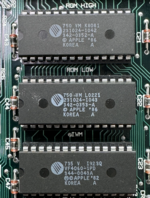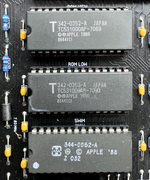I wish to humbly thank you for all your hard work on both of those topics!I went through all the documentation I could find on the IWM and the SWIM...
I'm meant to be finalising the 475 overclock code and doing testing on the 6200 and 6100... but I might do some digging if I have time.
By the way, this is the 1.44MB drive I've been using (pulled from one of my SE/30 machines) in conjunction with my SE Reloaded motherboard and IWM chip:
This evening, I booted into System 7.1 and launched MacTest SE and clicked the Options menu and chose Test Selections. I unticked everything but Disk Drives : Lower Drive (where I have the 1.44MB drive connected). I then proceeded to do the tests. It first asks for a blank 800K disk. Those tests passed. It then asks for a blank 1.44MB disk. Those tests passed as well. I knew they would pass based on my previous testing, but it's still nice to see that what I am experience is not a crazy fluke. It's reality.
I also ran the disk tests using Apple Personal Diagnostics v.1.1.3. It recognizes my drive as being a 1.44MB type. And when running the disk tests, if I insert a blank (but formatted) 800K disk, it will run and pass the tests. And if I then put in a blank (but formatted) 1.44MB disk, it also runs and passes the tests.
I plan to test my stock SE motherboard (which also has an IWM chip in it) tomorrow. If it works on that motherboard too, then would it really be two separate cases of a failed SWIM used as an IWM?
Also, it's important to remember that I can do everything I want with 1.44MB disks EXCEPT boot. It won't boot from 1.44MB disks (only 800K or 400K). But reads/writes and formatting on 1.44MB disks all work great.
If I can get my order filled with Kay Koba this week, and if he ships this week, it will probably arrive this week too (since we're both in Japan), and then I can test a SWIM, finally!
@Zane Kaminski
Putting 3 different ROMs on WarpSE will be simply outstanding!


